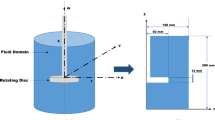Abstract
Harsh heat load conditions on plasma-facing components (PFCs) in steady-state and transient phenomena (e.g., disruptions and ELMs) in DEMO fusion reactors question the feasibility of current approaches based on solid targets made of tungsten. This issue calls for the development of innovative plasma-facing components. Liquid metal PFCs with strong convection enhance heat removal capability and resilience after the transient phenomena. However, transporting liquid metal across magnetic fields gives rise to MHD drag. MHD drag for the case of uniform B, estimated analytically, is acceptable. Grad-B MHD drags with straight ducts could seriously drag the LM flow across non-uniform B. Expanding the duct along B and shrinking the duct in a perpendicular direction could make electromotive force |vBh| approximately constant along the duct and significantly reduces the grad-B MHD drag. Here v denotes the flow velocity along the duct, B is the magnetic field strength, and h is the vertical duct size. Three-dimensional simulations for internal and free surface thermo-MHD phenomena have demonstrated that the proposed duct design reduces the total pressure drop along the duct.








Similar content being viewed by others
References
J. Wesson, Tokamaks (Oxford Univ. Press, Oxford, 2011)
Y. Ueda et al., Nucl. Fusion 57, 092006 (2017)
B. Badger et al. 1974 “UWMAK-I-A Wisconsin Toroidal Fusion Reactor Design” UWFDM-68
Y. Hirooka et al., Fusion Science and Technology 68 (2015), Proc. TOFE-2014
Robert Kaita, Plasma Phys, Control. Fusion (2019). https://doi.org/10.1088/1361-6587/ab4156
Y. Hirooka et al., Nucl. Fusion 50, 077001 (2010)
M. Ono et al., Nucl. Fusion 52, 037001 (2012)
G. Mazzitelli et al., Nucl. Fusion 55, 027001 (2015)
F.L. Tabares et al., Nucl. Fusion 56, 127002 (2016)
M. Shimada, Y. Hirooka, Actively convected liquid metal divertor. Nucl. Fusion 54, 122002 (2014). https://doi.org/10.1088/0029-5515/54/12/122002
M. Shimada, K. Tobita, Magnetically guided liquid metal divertor (MAGLIMD) with resilience to disruptions and ELMs. Plasma Fusion Res. 14(15), 1401011 (2020)
M. Shimada, Magnetically-guided liquid metal first wall (MAGLIMFW) with a built-in automatic disruption mitigation system. J. Fusion Energy. 39(6), 436–40 (2020). https://doi.org/10.1007/s10894-020-00257-2
P. Shercliff, Cambridge Philos. Soc. 49, 136–144 (1953)
L. Bühler, A parametric study of 3D MHD flows in expansions of rectangular ducts. Fusion Sci. Technol. 52(3), 595–602 (2007). https://doi.org/10.13182/FST07-A1553
K. Miyazaki, S. Inoue, N. Yamaoka, T. Horiba, K. Yokomizo, Magneto-hydro-dynamic pressure drop of lithium flow in rectangular ducts. Fusion Technol 10(3A), 830–6 (1986)
Jabir Al Salami “Numerical simulation of MHD free surface liquid metal flows for nuclear fusion applications.” Ph. D. Thesis, Kyushu Univ. (2022).
R. Moreau, S. Smolentsev, S. Cuevas, MHD flow in an insulating rectangular duct under a non-uniform magnetic field. PMC Phys. B. (2010). https://doi.org/10.1186/1754-0429-3-3
Acknowledgements
The authors acknowledge fruitful discussion with Prof. Yoshi Hirooka or Chubu University, Prof. Tomoaki Kunugi of Kyoto University, Dr. L. Zakharov, Prof. Egemen Kolemen, Prof. Rob Goldston and Dr. Masayuki Ono of Princeton Plasma Physics Laboratory. Grant-in-Aid for Challenging Research (Pioneering) establishment of basis for power generation with rift-up liquid metal 20K20445.
Author information
Authors and Affiliations
Contributions
M.S wrote the main manuscript and prepared figures 1-3. J.A.S. did the calculation, prepared figures 4-6 and drafted the numerical simulation part. All authors reviewed the manuscript.
Corresponding author
Ethics declarations
Competing interests
The authors declare no competing interests.
Additional information
Publisher's Note
Springer Nature remains neutral with regard to jurisdictional claims in published maps and institutional affiliations.
Rights and permissions
Springer Nature or its licensor (e.g. a society or other partner) holds exclusive rights to this article under a publishing agreement with the author(s) or other rightsholder(s); author self-archiving of the accepted manuscript version of this article is solely governed by the terms of such publishing agreement and applicable law.
About this article
Cite this article
Shimada, M., Al Salami, J., Hanada, K. et al. A Duct Design for Reducing Grad-B MHD Drag. J Fusion Energ 42, 50 (2023). https://doi.org/10.1007/s10894-023-00388-2
Accepted:
Published:
DOI: https://doi.org/10.1007/s10894-023-00388-2




